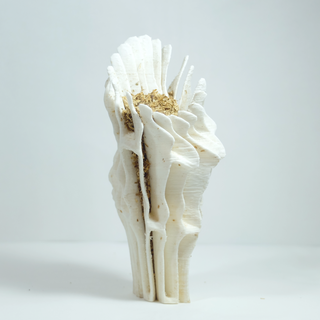
Hyper Articulated Myco-Morphs
2016/17
Category: Biomaterial Composite Prototype, Furniture Design
By: Jessica Dias
Advisor: Marcos Cruz
Assistant: Nina Jotanovic
Biology Support: Nuria Conde Pueyo
Computational Support: Rodrigo Aguirre
Fabrication Support: Mikel and Anya
The high consuming, disposable culture brought on by the Industrial Revolution is responsible for the fast production of non-renewable composite materials such as plastics that are as quickly disposed of as they are produced, and now remain a significant part of landfills and oceans.
As a result, myco-composite materials which are easily biodegraded, have been extensively researched and are slowly making their way into the market as alternatives to toxic synthetic, everyday-use products, their current designs, however, lack a level of aesthetic complexity. This research explores the feasibility of utilising living organisms to replace harmful synthetic materials by digitally fabricating a table prototype using 3D printed biodegradable PLA to act as a temporary scaffold for mycelium growth. The objective is to generate new and sophisticated aesthetic possibilities for myco-composite objects, by observing and simulating the behaviour of mycelium in various substrates and controlling environmental growth conditions.
In this approach, cultivation conditions, substrate recipes and consistencies, and the proportion of PLA has a direct effect on the behaviour and structural properties of the mycelium and consequently informs the final prototype morphology.
To alleviate some of the waste caused by the mass production of disposable plastic, the problem must be addressed at the start of the manufacturing process. This project sets out to develop a protocol for designing with mycelium and additive manufacturing to produce articulated myco-composite products that once disposed of, can adhere to nature's cycle.









This is a project developed at IAAC Institute for Advanced Architecture of Catalonia.

